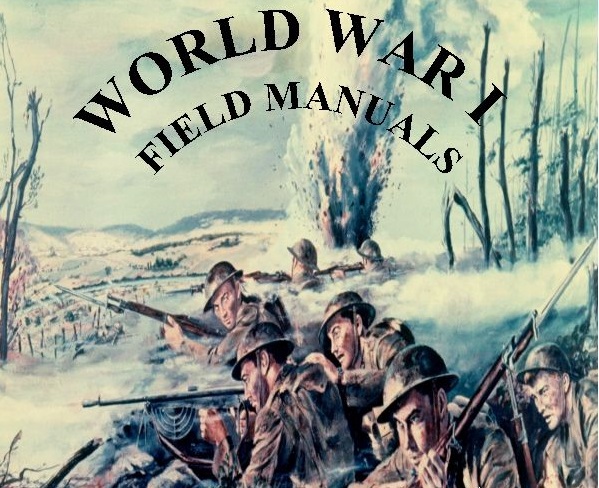
Description
World War I Era Military Manuals: A Thematic Timeline
Detailed Timeline of Main Events (Covered in Sources)
This timeline focuses on the key aspects and developments related to military practices, technology, and regulations during World War I as reflected in the provided list of field manuals. It’s important to note that this timeline is derived solely from the publication dates and content descriptions of these manuals and does not represent a comprehensive historical timeline of the war itself.
Pre-War Period:
- 1911-1917: Development and likely initial implementation of standardized infantry tactics and procedures are documented in the “Infantry Drill Regulations, 1911-1917“. This suggests a focus on basic combat formations, movements, and leadership principles before the full impact of trench warfare.
- 1913: Publication of the “Small Arms Firing Manual, 1913” indicates established doctrines for the use of individual firearms before the major escalation of the war.
- 1914: Publication of the “Interior Guard Duty, Manual, 1914-1917” outlines procedures for maintaining order and security within military camps and garrisons.
- 1914: Initial publication of the “Rules of Land Warfare, 1914” demonstrates the existing international legal framework governing armed conflict at the war’s outset, including adherence to conventions like The Hague and Geneva.
- 1915: Issuance of “Regulations for United States Military Telegraph Lines, Alaska Cables, Telegraph Stations, US Signal Corps 1915” highlights the importance of communication technology within the military, even in more remote locations.
- 1916: Development of insights into field fortification, potentially influenced by early war experiences, as indicated by “Notes on Field Fortification, for Use of Student Officers, Army School of the Line, 1916“.
Early to Mid-War Period (Emergence of Trench Warfare and New Technologies):
- 1917: Publication of “Construction of Dugouts, Textbook, 1917” explicitly addresses the defining characteristic of World War I: trench warfare. The manual’s content, “aided by experiences at Verdun and Somme,” signifies the adaptation of military knowledge based on the brutal realities of these major battles and the need for protection against artillery and gas.
- 1917: Updates to the “Rules of Land Warfare” (“Corrected to April 15, 1917”) reflect the ongoing nature of interpreting and applying the laws of war in the face of new tactics and technologies.
- 1917: The date range of “Infantry Drill Regulations, 1911-1917” and “Interior Guard Duty, Manual, 1914-1917” suggests ongoing revisions and adaptations of basic military procedures as the war progressed.
- 1917: Publication of “The Mess Officer’s Assistant” indicates a focus on the logistical challenges of feeding large armies and the importance of nutrition and food handling.
Late-War Period (Widespread Use of Gas and Evolving Tactics):
- 1918 (Various Dates): A significant number of manuals focus on gas warfare, indicating its prominent role in the later stages of the war and the urgent need for both offensive and defensive doctrines:
- AEF Combat Instructions, Pamphlet, 1918: Likely includes updated tactical guidance informed by the war’s progression, potentially incorporating lessons learned about gas and trench warfare.
- Defense Against Gas December 1918: Highlights the continued emphasis on protection against chemical attacks towards the end of the war.
- Employment of Machine Guns, AEF Bulletin No. 30, May 1918: Suggests a refinement of machine gun tactics based on wartime experience.
- Gas Manual Part 1 Tactical Employment of Gases
- Gas Manual Part 2 Use of Gas by the Artillery
- Gas Manual Part 3 Use of Gas by Gas Troops
- Gas Manual Part 4 Use of Gas by the Infantry
- Gas Manual Part 5 Use of Gas by the Air Service (Indicates the broadening application of gas warfare across different military branches).
- Gas Warfare Part 2 Defense Against Gas Warfare, AEF Pamphlet, January 1918: Underscores the critical need for effective countermeasures against gas attacks.
- The existence of multiple “Gas Manual” parts suggests a comprehensive effort to disseminate knowledge about the tactical and technical aspects of chemical warfare.
- 1918: Revision of the “Small Arms Firing Manual” (“Corrected to March 15, 1918”) implies ongoing adjustments to basic firearms usage based on wartime experiences.
- Instructions for the Defensive Combat of Small Units – Infantry Platoon to Regiment: This manual, based on “French, British and American Instructions” and “experience in the most recent operations at the time,” reflects a synthesis of Allied tactical knowledge gained during the war, specifically concerning defensive strategies in trench warfare.
- Provisional Machine Gun Firing Manual: The existence of this manual alongside the AEF Bulletin on machine gun employment suggests ongoing development and dissemination of best practices for this key weapon.
Post-War Period (Immediate Aftermath):
- Compilation of Circulars Containing Information and Instructions Relating To Demobilization of the Army: This document signifies the immediate post-war period and the logistical and administrative efforts involved in disbanding the large wartime army.
Ongoing/Unclear Timeline within the Sources:
- Bulletin for Field Officers Number 6: The specific date is not provided, but its title suggests it was a communication issued to high-ranking officers during the war, containing important information or instructions.
- Coast Artillery Drill Regulations, United States Army: The date is not specified, but it indicates the existence of specialized training and procedures for coastal defense artillery during this era.
- Drill Regulations and Service Manual for Sanitary Troops, United States Army: The date is not specified, but it reflects the importance of medical services and hygiene within the military during wartime.
- Manual for Noncommissioned Officers and Privates of Field Artillery of the Army of the United States, Volume I & II: The dates are not specified, but these manuals provided essential knowledge for artillery personnel.
Cast of Characters (Principle People Mentioned in the Sources)
This section lists the principal types of individuals and groups mentioned or implied within the context of the field manuals, rather than specific historical figures.
- Commanding Officers: Individuals holding leadership positions responsible for implementing tactics, managing troops, and making strategic decisions. Their needs are addressed in manuals like “Construction of Dugouts” (dugouts for their posts) and “Bulletin for Field Officers Number 6“.
- Infantry Personnel: The core fighting force, extensively covered in manuals such as “Infantry Drill Regulations” and “Instructions for the Defensive Combat of Small Units“. They are the primary recipients of training on basic combat, attack, defense, and gas warfare.
- Artillery Personnel: Responsible for the operation and deployment of artillery, including the use of gas shells, as detailed in “Gas Manual Part 2 Use of Gas by the Artillery” and “Manual for Noncommissioned Officers and Privates of Field Artillery“.
- Machine Gunners: Specialized troops operating machine guns, with dedicated training outlined in the “Provisional Machine Gun Firing Manual” and “Employment of Machine Guns, AEF Bulletin No. 30“.
- Gas Officers/Gas Troops: Personnel specifically trained in the tactical employment and handling of chemical weapons, indicated by “Gas Manual Part 3 Use of Gas by Gas Troops“.
- Medical Personnel (Sanitary Troops): Responsible for the care of the sick and wounded, with their duties and regulations outlined in “Drill Regulations and Service Manual for Sanitary Troops“.
- Engineers: Involved in the construction of fortifications and dugouts, as detailed in “Construction of Dugouts” and “Notes on Field Fortification“.
- Signal Corps Personnel: Responsible for military communications, as indicated by “Regulations for United States Military Telegraph Lines“.
- Mess Officers: In charge of the logistical aspects of feeding troops, guided by “The Mess Officer’s Assistant“.
- Interior Guards: Personnel tasked with maintaining order, protecting property, and enforcing regulations within military camps, as described in “Interior Guard Duty, Manual“.
- Military Police/Provost Guards: Responsible for law enforcement and maintaining order within the military more broadly (mentioned within “Interior Guard Duty, Manual“).
- Mounted Scouts: Infantry personnel utilizing horses for reconnaissance (mentioned within “Infantry Drill Regulations“).
- Carrier Pigeons: Used for communication, requiring specific protection against gas attacks (mentioned in “Gas Warfare Part 2 Defense Against Gas Warfare“).
- Student Officers: Individuals undergoing training, for whom manuals like “Notes on Field Fortification” were specifically prepared.
- Air Service Personnel: Involved in the use of gas from aircraft, as indicated by “Gas Manual Part 5 Use of Gas by the Air Service“.
- Officers of the Land Forces of the United States: The primary audience for the “Rules of Land Warfare“, responsible for understanding and adhering to the laws of war.
- Noncommissioned Officers and Privates: The enlisted ranks who are the primary recipients of much of the training and procedural information contained in these manuals.
- Belligerents: The opposing sides in the conflict, whose actions and tactics influenced the development of these manuals (e.g., early German respirators mentioned in “Gas Warfare Part 2 Defense Against Gas Warfare“).
- Neutral Parties: Nations not involved in the conflict, whose rights and duties are outlined in the “Rules of Land Warfare“.
World War I Field Manuals
3,413 pages of World War I era field manuals, textbooks, pamphlets, and bulletins. The 25 manuals date from 1913 to 1919.
Highlights amongst the manuals include:
Construction of Dugouts, Textbook, 1917
One of the most recalled characteristics of World War I is the stalemate of trench warfare. This manual details the construction of trenches, both underground and surface dugouts. The knowledge in this manual was aided by experiences at Verdun and Somme. Subjects include: Protection against gas attacks, Machine gun emplacements, Dugouts for the posts of commanding officers, Medical stations, Observation posts, concealment during construction, living conditions in underground dugouts, and preventing rain and water seepage.
Gas Manual Part 1 Tactical Employment of Gases
Another image commonly invoked by World War I is the use of chemical warfare. This manual states: “The introduction and development of the use of gas in military operations has had a marked effect on the action and employment of troops in combat. A proper tactical training now requires careful Instruction not only in measures of defense against gas, but in the use of gas against the enemy in offensive and defensive operations.”
Topics include: Importance of Gas as Weapon in Military Operations. Chemical Substances Used in Military Operations: Their Physical Properties, Their Physiological Effects, Effect in Relation to Density of Gas and Time of Exposure. Action of Gas Upon Release from Containers. Persistencies of Gases. Methods of Projection of Gas. Employment of Chemical Substances in Tactics. Special Application of the Various Groups of Chemical Substances. Who Uses Smoke. Use of Smoke in Operations. Smoke Screens. Protection of Tanks.
Gas Manual Part 2 Use of Gas by the Artillery
The information in this American Expeditionary Forces field manual on the use of gas in artillery shells, was compiled with the purpose of furnishing the artillery man and the gas officer concise information on the use of chemical ammunition. Topics include: Tactical Use of Artillery Chemical Shell. Handling and Storage of Gas Shell. Transport of Gas Shell. Storage of Gas Shell. Special Precautions Relative to Mustard Gas Shell. Incendiary Shells.
Gas Warfare Part 2 Defense Against Gas Warfare
Topics include: Early Methods of Protection: (a) Early British Respirators and Helmets. (b) Early German Respirators. (c) Oxygen Breathing Apparatus. (d) Other Early Methods. Present Day Masks: (a) American Respirator. (b) French Masks. (c) The Italian Mask. (d) The Russian Respirator. (e) German Respirator. Anti-Gas Appliances for General Use: (a) Alarm Appliances, Gas Shell and Local Alarms, Cloud Gas Alarms. (b) Protection of Shelters and Dugouts. (c) Clearing Gas from Trenches and Dugouts, Natural Ventilation, Ventilation by Fire, Ventilation by Fanning. Protection of Weapons and Equipment. Protection of Animals, Horse, Carrier Pigeons. Gas Detectors and Sampling Devices. Organization of Anti-Gas Duties. Standing Orders for Defense Against Gas Attacks, American Expeditionary Forces.
Infantry Drill Regulations, 1911-1917
This manual covers a wide range of basic standards for the infantry. Topics covered include: Orders, commands, and signals. Combat leadership. Combat reconnaissance. Fire superiority. Deployment for attack. Advancing the attack. The fire attack. The charge. Pursuit. Attack of fortifications. Holding attack. Defensive positions and entrenchments. Deployment for defense. Defensive counterattack. Delaying action. Machine guns. Ammunition supply. Mounted scouts. Night operations. Infantry against Cavalry. Artillery supports. Entrenchments. Patrols. Marches. Training and discipline. Protection of the march. Camp sanitation. Protection of camp or bivouac. Ceremonies and inspections. Honors and salutes. Bugle calls. Bugle call music notations. Bayonet usage.
Instructions for the Defensive Combat of Small Units – Infantry Platoon to Regiment
This field manual concentrates on the characteristics of trench warfare. These Instructions were adapted from French, British and American Instructions and other sources, and were based on experience in the most recent operations at the time. The manual explains the general characteristics of offensive and defensive combat in trench warfare. The manual discusses the employment of natural and artificial features of the ground and the improvement of same for increasing the power of the defense as an essential part of defensive combat. The manual contends that an entrenched position furnishes a large number of natural and artificial features which may be employed for defensive combat. Topics covered include: Characteristics of the Attack. Infantry During the Period of Stabilization. Infantry Attacked in its Trenches. Fire Trenches and Communication Trenches. Cave Shelters. Wire Entanglements.
Interior Guard Duty, Manual, 1914-1917
This manual divides guards and guard duty into four classes: Exterior guards, interior guards, military police, and provost guards. Interior guards are used in camp or garrison to preserve order, protect property, and to enforce police regulations.
Provisional Machine Gun Firing Manual
This manual covers the use of the Benet-Mercie rifle, Lewis gun, Vickers gun, and the Maxim gun. Topics include: Use, care, and repair of machine guns and accessories. Combat firing. Instruction in the mechanics of the machine gun. Sighting, position, and aiming drills. Use of instruments. The determination of ranges. Estimating distances on the ground by eye. Field firing. Indirect fire. Night firing. Ballistic qualities of machine guns. Rates and volumes and their relation to effectiveness.
Rules of Land Warfare
This manual on the rules of land warfare was prepared for the use of officers of the land forces of the United States during World War I. The manual covers conventions and treaties such as the Hague and Geneva conventions. The manual covers subjects omitted by these conventions. Topics include: The laws of war on land. The commencement of hostilities. The armed forces of belligerents. Prisoners of war. The sick, wounded, and dead. The conduct of hostilities. Stratagems. Espionage and treason. Bombardments, assaults, and sieges. Intercourse between belligerents. Capitulations. Armistices. Military authority over hostile State. Treatment of enemy property. Penalties for violations of the laws of war. Neutrality. Neutral rights and duties. Convention III of The Hague. Convention IV of The Hague. Convention V of The Hague. Convention VIII of The Hague. Convention IX of The Hague. Convention XI of The Hague.
The Mess Officer’s Assistant
This book teaches the essential principles to be followed in the messing of troops. Topics include: History of The Ration. Food Values and Elementary Principles of Nutrition. Elementary Principles of Cooking and Handling Food. The Garrison Ration. Milk, Cheese, Lard, Compound, Etc. Preservation of Foods, Bacteria and Mold.
Manuals included on the disc are:
AEF Combat Instructions, Pamphlet, 1918
Bulletin for Field Officers Number 6
Coast Artillery Drill Regulations, United States Army
Compilation of Circulars Containing Information and Instructions Relating To Demobilization of the Army
Construction of Dugouts, Textbook, 1917
Defense Against Gas December 1918
Drill Regulations and Service Manual for Sanitary Troops, United States Army
Employment of Machine Guns, AEF Bulletin No. 30, May 1918
Gas Manual Part 1 Tactical Employment of Gases
Gas Manual Part 2 Use of Gas by the Artillery
Gas Manual Part 3 Use of Gas by Gas Troops
Gas Manual Part 4 Use of Gas by the Infantry
Gas Manual Part 5 Use of Gas by the Air Service
Gas Warfare Part 2 Defense Against Gas Warfare, AEF Pamphlet, January 1918
Infantry Drill Regulations, 1911-1917
Instructions for the Defensive Combat of Small Units – Infantry Platoon to Regiment
Interior Guard Duty, Manual, 1914-1917
Manual for Noncommissioned Officers and Privates of Field Artillery of the Army of the United States, Volume I
Manual for Noncommissioned Officers and Privates of Field Artillery of the Army of the United States, Volume II
Notes on Field Fortification, for Use of Student Officers, Army School of the Line, 1916.
Provisional Machine Gun Firing Manual
Regulations for United States Military Telegraph Lines, Alaska Cables, Telegraph Stations, US Signal Corps 1915 (Manual No.2)
Rules of Land Warfare, 1914, Corrected to April 15, 1917 (Changes Nos. 1 and 2)
Small Arms Firing Manual, 1913 Corrected to March 15, 1918)
The Mess Officer’s Assistant
The files contain a text transcript of all recognizable text embedded into the graphic image of each page of each document, creating a searchable finding aid. Text searches can be done across all files in the collection.

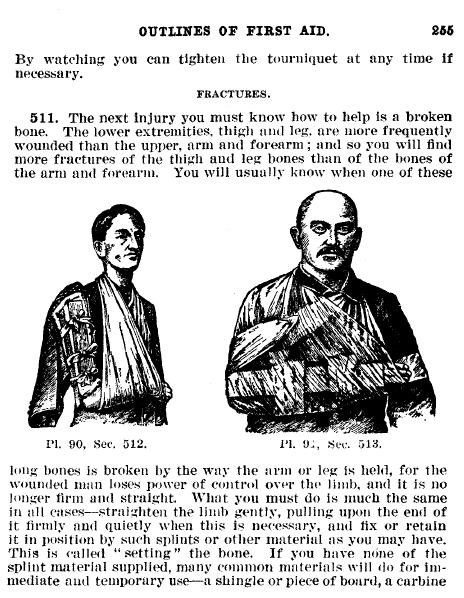
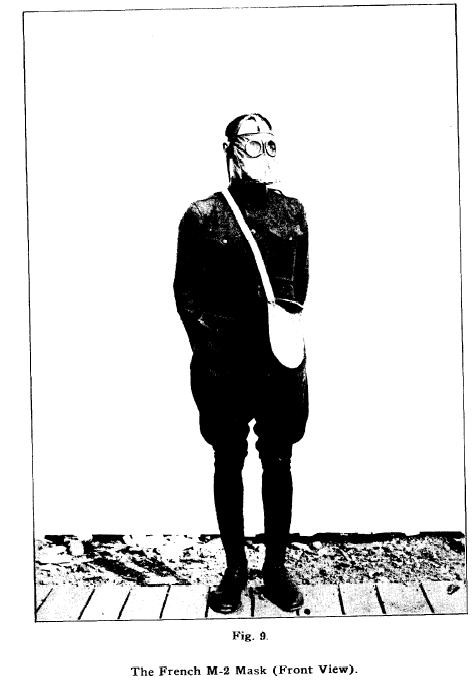

Related products
-
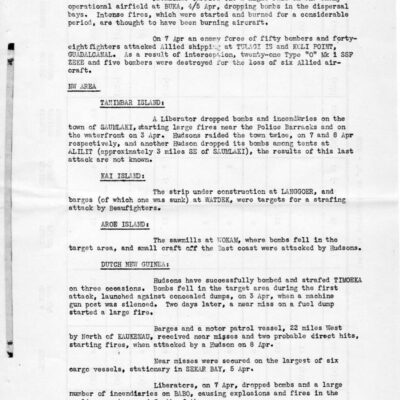
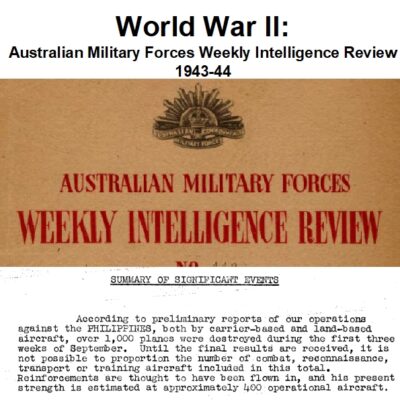
World War II: Australian Military Weekly Intelligence Reports 1943-44
$3.94 Add to Cart -


Operation POPEYE in the Vietnam War
$5.94 Add to Cart -
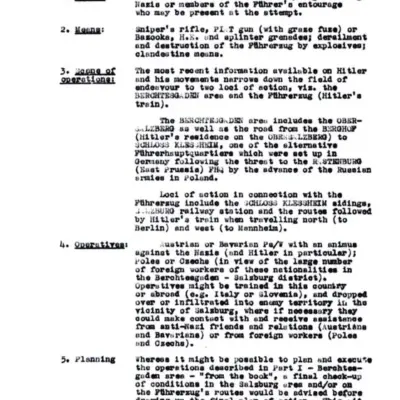
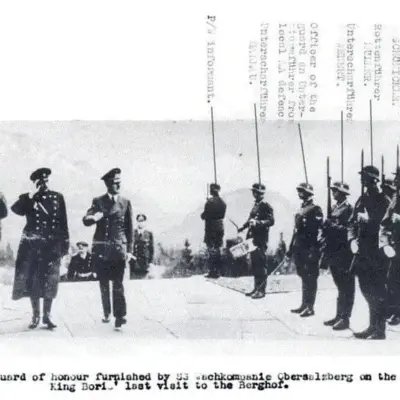
World War II: Adolf Hitler and Operation Foxley – British Assassination Plot
$19.50 Add to Cart -
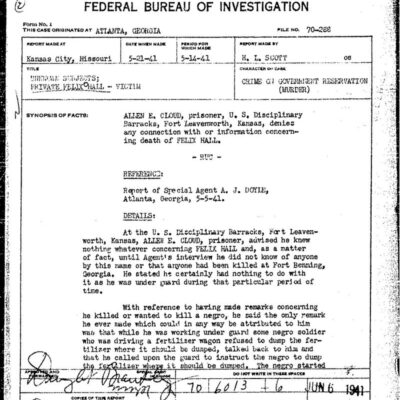
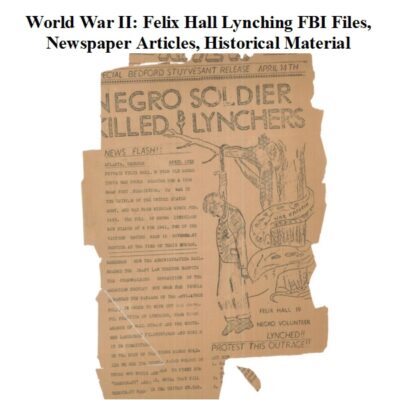
World War II: Felix Hall Lynching – FBI Files, Articles, Historical Records
$9.99 Add to Cart